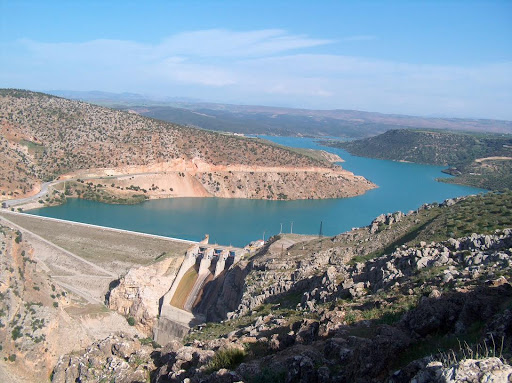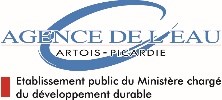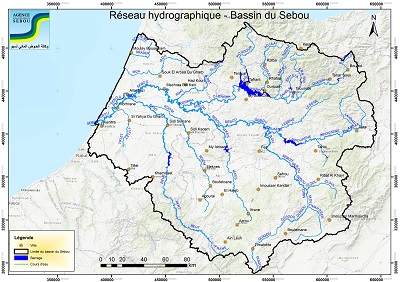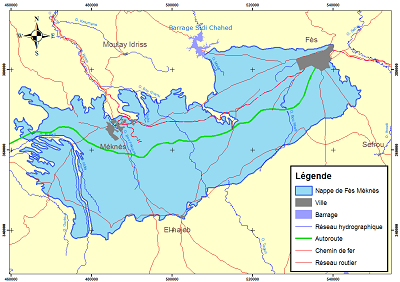
PROJECT TITLE:
SAFEGUARDING THE FES-MEKNES WATER TABLE AND AGRICULTURAL ACTIVITY IN THE SAISS PLAIN SUBJECT TO HIGHLY IMBALANCED RESOURCE/DEMAND THROUGH A RENEWED PARTICIPATIVE MANAGEMENT CONTRACT AND IMPROVED MONITORING OF THE WATER TABLE
COUNTRY:
Morocco
LOCATION :
Sebou basin – Fes-Meknes water table
SCALE OF INTERVENTION:
Territorial
INCUBATION LED BY:
LOCAL CONTEXT AND ISSUES:
The Saïss basin covers an area of 2,200 Km2 and is home to a population of about 3 million, 72% of them in urban areas and 28% in rural areas. This basin features an aquifer system of major socio-economic importance, partly due to its contribution to the drinking water supply of the cities of Fes, Meknes and neighbouring agglomerations, and partly due to its role in the development of the agricultural sector, for which the plain has an overall potential of about 160,000 hectares, including 50,000 currently irrigated from elsewhere.
A succession of annual droughts since the 1980s and anarchic use of water has led to the overexploitation of groundwaters. Annual figures for the Fes-Meknes water table show a shortfall of around 100 Mm3/year. This shortage is translated by a continual drop in the piezometric level (average of 3m/year), a reduction in the artisan aquifer, and the drying-up of some rivers and springs. If pressure on groundwater in the Saïs Plain continues at the same pace, it will threaten the water supply in the short and mid terms with negative impacts on farming, tourism, industry, the economy and the environment.
To tackle this problem, a new form of groundwater governance has been initiated. It is based on the participation and involvement of regional and local partners in managing these resources by applying a participatory concertation process involving the establishment of an aquifer contract.
This contract takes a sustainable development perspective to engage all stakeholders and users in defining a multiannual action plan to implement the action agreed on and to define the nature of their mutual commitments in conformity with the framework convention of the contract and the related specific conventions. Steering and monitoring committees set up at regional, provincial and local levels ensure that the aquifer contract is respected, act as arbitrators in case of conflict, and suggest measures and projects to improve current regulations.
The framework convention of the Fes-Meknes aquifer contract, which was initiated by the Sebou Water Basin Agency (WBA), focuses on four main areas: development of the water available, management and protection of groundwaters, knowledge building, and communication and training.
However, the framework document engaging stakeholders has not been made concrete by an official signature. This lack of political validation has not held back the project to replenish the Saïss Plain, currently under way. This project, which features in the aquifer contract’s programme of action, includes a reservoir on the Upper Sebou and the transfer of stored water to the Saïs Plain. The project currently being implemented should relieve groundwater abstractions thanks to this external input, and includes multiannual monitoring of the effects of the replenishment on the Fes-Meknes water table. This impact needs to be measurable, regularly monitored, and shared with stakeholders.
PROJECT GOALS:
Although the external inflow (reservoir on the Upper Sebou) feeding into the Fes-Meknes water table at the level of the Saïss Plain is not closely regulated by the Water Basin Agency through the renewal of the aquifer contract and a system of permits and levies, it could involve the following:
- An increase in irrigated surfaces, since current resources have held back planted surface areas and inputs for crops.
- A refusal to abandon existing boreholes and replace them by external inflows for financial reasons.
- As a consequence, the continued deterioration of groundwater beyond its current level.
- In addition to the environmental impact: the threat of rural exodus due to bankrupt businesses if vigorous action on the field is not organised to achieve an optimal, sustainable balance between resource and demand.
The incubation aims to implement a support programme for the Water Basin Agency to consolidate its aquifer contract project, with a focus on the following:
1. Building knowledge and reactivating governance
Renewal of the management plan and reactivation of the aquifer contract led by a specific coordinator for:
a) Revision of the contract in concertation with project leaders.
b) Constant awareness-raising of the fragility of water by stakeholders and civil society.
c) Work under the authority of a steering committee comprising regional and local elected representatives, user representatives and state services.
d) Follow-up on the implementation of actions in the contract until its termination.
Hydrographic district - Sebou Basin © Sebou Water Basin Agency

Allal Al Fasi - Sebou River © Sebou Water Basin Agency
2. Organising the monitoring programme in order to closely analyse the impact of action undertaken on the water table
For the aquifer contract:
- Set up a coordination and awareness-raising unit to work under the authority of a small group similar to the WBA’s Sebou-Region-Agriculture group to work on a revision of the contract. The unit will also be responsible for running meetings, preparing working documents and writing up documents validated at meetings.
- Set up a steering committee and a smaller monitoring committee with the aim of associating local stakeholder representatives as closely as possible with the work.
- Draw up the statutes of the leading body (coordination unit) and the operating rules for the steering and monitoring committees.
- Collect recent data, meet and motivate stakeholders, get to know the context to be in a position to revise and update the current contract, and complete it with new actions (e.g. work on soils or irrigation methods) to make it operational by meeting project leaders and financers and developing action sheets that can be subject to a contract.
- Propose awareness-raising actions led by governance: messages, tools and vectors devised to reach a maximum number of citizens, with a particular focus on good farming practices.
- Ensure monitoring and evaluation of actions in the contract, co-financed by the Sebou Water Basin Agency, in terms of resources but also by analysing other parameters like the quality of produce, the economic impact for farmers, evolving farming practices, and even the quality of soil over time, or any other parameter that might be pertinent in the current context.
For the monitoring part of the project “M’Dez and transfer of Sebou waters to the Saïs”:
- Build knowledge on groundwater to reach a better definition of the different water bodies that make up the Fes-Meknes water table.
- Better target overexploited areas by combining hydrogeology with identification of withdrawals.
- More specifically equip the sensitive areas thus identified by completing the current arrangements.
- Operate the entire system, within the Sebou Water Basin Agency, continuously and in compliance with the current monitoring mechanism that has succeeded in alerting all stakeholders about the dramatic situation of the water table (drop of 3 metres per year for over ten years).
- Reinforce the Water Basin Agency’s means of action and management by producing a tool to manage permits, levies and finances.
SDGs TARGETED BY THE PROJECT:
CHALLENGES FACING THE PROJECT:
Water resources management - Protection of soil and ecosystems – Action to control desertification and flooding
SECTORS CONCERNED:
Agriculture – Water security – Food security - Protection and management of water and land ecosystems – User resilience
EXPECTED OUTCOMES:
Water table monitoring
Monitoring:
- Complementary hydrogeological study to precisely define water bodies and analyse their sensitivity to abstraction (supply/demand comparison).
- Definition of reinforcement of the monitoring system to put in place to obtain a more precise and pertinent vision of how the water table operates.
- Establishment of a basic model of the overall operation of the water table, based on volumes withdrawn, recharge rate, and the capacities of the aquifer.
- Definition and initialisation of supplementary parameters to monitor.
Modernisation and reinforcement of governance
Management:
- Diagnosis and understanding of current tools and the objective sought.
- Merging of current tools for managing permits and levies.
- Integration of compatibility.
Coordination:
- Understanding of the context and preparation of statutes of the leading body.
- Summary of existing data supplemented by current studies.
- Meetings with and motivation of stakeholders likely to carry through planned or new action.
- Writing-up of the new contract.
- Development of action sheets based on work with financers to present a draft operational contract featuring production deadline and possible financing.
- Signature of contract.
- Follow-up on implementation of actions in the contract following an established timetable.
- Evaluation of action: water resources, economic and social impacts, etc.
Set-up of long-term finance mechanisms
Financial incentives for emblematic water-saving operations:
- Cofunding of actions identified in the updated aquifer contract, chosen because they feature water-saving initiatives, innovations like recycled wastewater, different irrigation modes, or measures aimed at improving the water-retention capacity of soil.
Capacity and knowledge building
Awareness-raising:
- Suggested messages, tools and vectors to raise the awareness of all stakeholders to use water sensibly.
- Closer targeting on the farming profession, the biggest consumer of water, to set up a code of good farming practices.
PROJECT STAKEHOLDERS:
Stakeholders involved:
All stakeholders and users of the Fes-Meknes water table in the Saïss Plain (farmers, livestock breeders, etc.) – institutional stakeholders
Project leaders:
Sebou WBA - Stakeholders of the Fes-Meknes aquifer contract - International Office for Water
Funder of the incubation process:
Artois-Picardie Water Agency
ESTIMATED COST OF PROJECTS IDENTIFIED FOR INCUBATION:
>1 million EUR
SHORT-TERM ACTION (3 YEARS)
- Complementary water study
- Measuring networks to be completed
- Coordination and awareness-raising
- Water table monitoring management
LONG-TERM ACTION (10 YEARS)
- Water efficiency
- Governance to be reinforced locally




